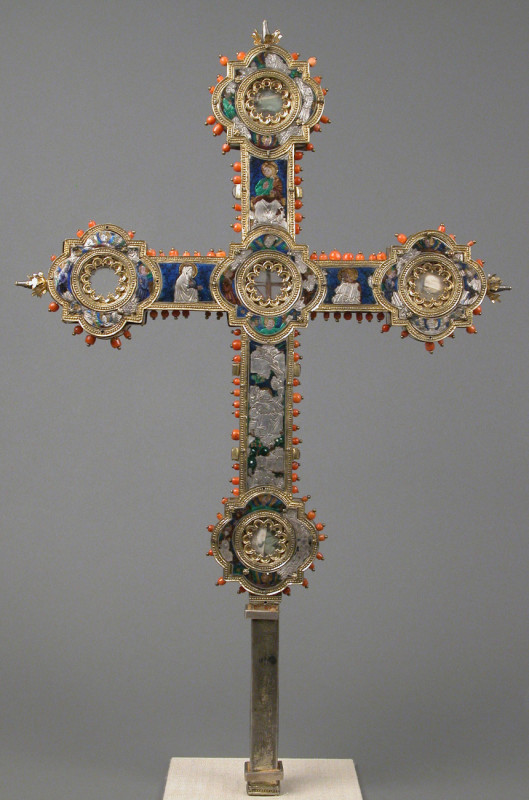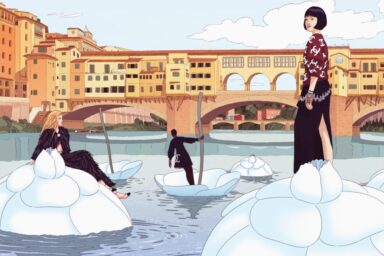Heavenly Bodies – Fashion and the Catholic Imagination- The Met’s Costume Institute’s Spring 2018 Exhibition at The Met Fifth Avenue and Met Cloisters
Text by: Riccardo Slavik
Images courtesy of The Metropolitan Museum of Art, Digital Composite Scans by Katerina Jebb
“The Catholic imagination in all its many manifestations . . . tends to emphasize the metaphorical nature of creation. . . . Everything in creation, from the exploding cosmos to the whirling, dancing, and utterly mysterious quantum particles, discloses something about God and, in so doing, brings God among us.” Father Andrew Greeley, The Catholic Imagination

After a long night of tweeting insults at badly dressed celebrities attending the Met Gala for the opening of Heavenly Bodies: Fashion and the Catholic Imagination, I caught up with a friend who works in fashion on the phone and his first comment was ‘ It was so bad the outfits looked so old, nothing modern going on’ and I had to respond that, well, that was the point, there’s nothing even vaguely new or modern about Catholicism, no matter how hard Pope Francis’ PR team works. My personal favorite look of the evening was Madonna’s and she looked like a Spanish Infanta going to a funeral at Queen Victoria’s court. In Fashion, if you get into a museum while still alive, it means it’s at least the beginning of the end. Saint Laurent’s decline started after his own Met exhibition, which, by the way, was the first step in Pierre Bergè’s plan to canonise him as the Fashion Saint, the Artist as Tortured Soul. In a way, this exhibition can be seen as the closing chapter in the diminishing influence the Catholic Church has had over the arts in the last century or so.

starsAs an atheist and an unexpectedly practical person, my relationship with the Catholic Church ended the moment I found out I wasn’t allowed to receive any gifts for my First Communion ( which i took anyway, just to prove that I wasn’t doing it for the gifts, but I digress). The Pomp and Circumstance, the High Drama that permeates its rituals and traditions never really excited me, but, like Opera, they have influenced for centuries artists and artisans, often inspiring them to create absolute masterpieces. 20th century Fashion, eurocentric as it was, has obviously been enormously influenced by catholicism, both as a visual blueprint and simply by osmosis, after all, France and Italy, the main purveyors of Couture and Pret-a-Porter, are still, at heart very catholic, at least on a superficial level. And I say on a superficial level because, despite the recent rise in conservative, fascist-leaning political groups that try to use religion as a weapon, Europe, historically the heartland of Christianity, has become the world’s most secular region over the last half century ( as measured by church attendance, self-reported affiliation and other indicators) . Looking at one of the countries that make up a big portion of this Met exhibition it’s interesting to note that 64% of 16-29 years olds in France don’t consider themselves affiliated to any religion, and only 25% describe themselves as Christian. Even Italy, traditionally a catholic stronghold, and religiously and politically influenced by the very real power of the Vatican State, has seen in 2016 only 68% of youths 15-34 identify themselves as Catholic. Africa, and Latin America, are the only areas where the Catholic Church is making any actual progress.
This trend towards secularism helps frame the Met exhibition in a less controversial way, as we move away from the practical and moral influence of the Church ( and its many sins and blunders) we can now look at how the Catholic Church has inspired and at times supported the arts through the centuries, leaving us with an immense body of work from which Fashion, as many other facets of artistic expression, has been able to take inspiration. Let’s not forget that Popes have been for centuries also Kings, with very secular reigns and possessions and their riches were often translated in sumptuous religious garments or paintings. Anyone who’s ever been at the Vatican Museums knows that the luxury of their jewels and habits can hardly be surpassed. No wonder then that designers and couturiers like Versace or Balenciaga would find inspiration in the intricate embroideries, the bejewelled robes or even just the simplicity of a nun’s habit. The Sunday Mass has also always been the traditional space to congregate and dress up, weddings, baptisms and other various religious functions were the perfect excuse for a new dress, a hat, a splurge.
Let’s not forget that The Catholic Church’s iconography has provided us with innumerable images of unforgettable female figures, the Madonna, probably the most represented figure in Art, and a plethora of saints, martyrs and sinners, images at times pious at times extravagantly celebratory, painted on wood or sculpted in gold and precious stones, they have been branded in the minds of artists, artisans and designers even in modern times. A certain chic love for kitsch has even revalued a flashier, cheaper kind of religious image as, for example, the Italian ‘santini’. Just think of the amazing images shot by Pierre et Gilles of famous popstars as various minor saints and/or religious figures.

‘While some practicing Catholics might perceive certain fashions shown as indelicate or even offensive, and other Catholics and non-Catholics alike may be concerned that fashion is an unfitting and unseemly medium by which to convey ideas or reflect imagery related to the sacred and the divine, dress is fundamental to any discussion about religion. Throughout the history of the Catholic Church, dress has affirmed religious allegiances, asserted religious differences, and functioned to distinguish hierarchies as well as gender. Although some might regard fashion as a frivolous pursuit far removed from the sanctity of religion, most of the vestments worn by the secular clergy and religious orders of the Catholic Church actually have their origins in secular dress.’ Andrew Bolton, Wendy Yu Curator in Charge, The Costume Institute
Fashion and Church have always had a complicated yet close relationship, A tension between Opulence and Frugality that is at the core of both and which the ambitious and sprawling exhibition ( their biggest yet), curated as usual by Andrew Bolton, tries to portray at its best.

The Costume Institute’s exhibition, Heavenly Bodies: Fashion and the Catholic Imagination, on view from May 10 through October 8, 2018 will be presented in two Metropolitan Museum of Art locations: at The Met Fifth Avenue—in the medieval galleries, and the Anna Wintour Costume Center—and uptown at The Met Cloisters. The thematic exhibition will feature a dialogue between fashion and masterworks of medieval art in The Met collection to examine fashion’s ongoing engagement with the devotional practices and traditions of Catholicism. A group of papal robes and accessories from the Vatican will travel to the United States to serve as the cornerstone of the exhibition, highlighting the enduring influence of liturgical vestments on designers.
www.metmuseum.org/HeavenlyBodies




